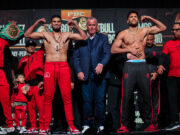
In February local fans attended “Welcome to the Future” in San Antonio’s Alamodome to see how Julio Cesar Chavez Jr. would finally fare against a fellow Mexican. Aficionados, though, attended the event to see the “Filipino Flash” – a man whose talents were large enough to place his name among prizefighting’s elitist. Nobody was disappointed, and nobody was overwhelmed.
Saturday in what appeared to be a half-filled Home Depot Center tennis stadium in Carson, Calif., Nonito Donaire returned to HBO’s airwaves, this time a headliner, against a tall South African super bantamweight named Jeffrey Mathebula. Donaire won a unanimous decision, dropping Mathebula in the fourth round and generally outclassing the gangly South African throughout, and again nobody was disappointed and nobody was overwhelmed.
But the birdy hop made another appearance. It was its third apparition in as many fights for Donaire, a thing that happened before the midway point of each fight, within a round or two of Donaire’s realizing he’d be unable to stop his opponent in the spectacular, one-shot way he stopped Vic Darchinyan five years ago or Fernando Montiel two Februaries past.
The birdy hop happens when Donaire squares his feet, drops his hands to his sides, sets his face forward, and begins to hop frantically about an opponent, like an incited goldfinch, flapping his gloves threateningly. Sometimes he throws punches, occasionally he lands them cleanly, but mostly he hops hither and yon in an expression of frustration intended to provoke an opponent’s reciprocal frustration.
It is a wonder Donaire’s trainer Robert Garcia allows the birdy hop; it seems antithetical to what Garcia’s gym of seriously striving Mexican journeymen tries to be about. One imagines if the birdy hop came out in sparring with another of Garcia’s charges, five or six of his mates would gang up on Donaire in the restroom of an Oxnard restaurant and deliver schoolyard justice. Or is that “bullying”? The reason that doesn’t happen seems to be that Donaire doesn’t belong in Garcia’s gym as much as Kelly Pavlik does, and Pavlik – a long pressure fighter with a once-stupendous right cross – belongs there only insomuch as Oxnard, Calif. is not Youngstown, Ohio.
In San Antonio, Donaire did a mitts session with retired champion Jesse James Leija, and Leija came away from the session impressed by Donaire’s interest in trying new things – an informal curiosity betrayed by Donaire’s casual employment of the word “fun” in fight descriptions. Donaire’s pursuit of fun in the ring, though, now begins to undo his pursuit of stardom.
Local newspaper reporters always come away from boxing’s prefight promotions impressed by a B-side’s charisma and how much more time he has for them than the A-side fighter does. Donaire has a special gift for being an A-side fighter who makes himself B-side accessible during a promotion. He performs a public-workout routine where he invites youngsters to join him in the ring. He dresses well and speaks so respectfully most overlook his saying the same things everyone else does.
All of this is tolerable, nay, commendable, when Donaire blows through highly regarded opponents. The façade’s plastic shell, though, become less impressive the more time Donaire spends across from men like Omar Narvaez (UD-12) and Wilfredo Vazquez Jr. (SD-12) and Jeffrey Mathebula (UD-12). HBO viewers, three times now, have turned on a Donaire fight to see a prodigy and instead have seen talent shy of prodigious, shy of the mark set by the man whose image is meant to be conjured by the “Filipino” part of the Flash’s nickname.
Against Narvaez, Donaire’s elite talents were stymied by his opponent’s defensive posture – what Carlos Acevedo, with characteristic panache, called “airplane-crash position” – against Vazquez it was a broken hand or blood vessel, and against Mathebula it was a pair of sleepy legs.
Much has been made of Donaire’s noble choice to subject himself to year-round Voluntary Anti-Doping Association (VADA) testing. The group’s evangelists hope Donaire’s example will become a standard in prizefighting. Donaire’s unripped physique, stay-at-bantamweight power and dead legs, though, do not thus far bode well for the group’s prospects. There is an important balance to be struck between entertaining spectacle and fighter safety – which are not allies – and it remains to be seen if year-round drug testing is the way to accomplish it.
Balance is also part of what has claimed Donaire’s power in his most recent three fights. His balance was perfect when he clipped Montiel 17 months ago in one of his career’s two signature knockouts, but it has been imperfect since. Some of this is performance anxiety; as a man who nears his 30th birthday, Donaire realizes he’ll not be a “young superstar” in boxing much longer and tries to force a spectacular knockout in the first five minutes of each match. Some of it, too, is the nature of added weight. Just three years ago, Donaire fought 10 pounds lighter than he does now.
Quite a bit of Donaire’s newly imperfect balance, though, is attributable to his being hit more often. After Saturday’s fight, he said imperfect balance was the only thing that came between his dropping Mathebula with a round-4 counter left hook and taking Mathebula’s consciousness entirely. That’s true, but so is this: Donaire’s balance was compromised by catching most of Mathebula’s right cross with the left side of his head before throwing the counter hook over Mathebula’s outstretched arm.
Postfight talk turned to Donaire’s next opponent and his trying to become the next Asian fighter to accumulate titles of all different kinds in all different weight classes. It will not be lost on historians, however, that Donaire did not unify the bantamweight division before moving on to 122 pounds, missing quite notably the winner of Showtime’s Bantamweight Tournament. And it will not be lost on anyone if Donaire grows his way out of the super bantamweight division without first fighting Guillermo Rigondeaux.
Bart Barry can be reached at bart.barrys.email (at) gmail.com





















